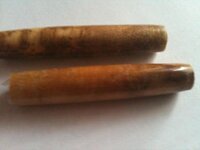Tiger
Member
I hope you can see this from the picture but I was working on some olive wood and applied my CA finish, then MM Brasso and Swirl Remover. I wasn't totally satisfied with the finish so I sanded it right back to 240 grit and reapplyed everything, all going ok put the final touches on it and after a few seconds patches of white. I then rub this with Brasso and they go away but only for a moment, rub Brasso and goes away but after a few seconds it comes right back. It looks like some of the old CA trapped between the new one and the wood, is that correct or is it something else?
If I wanted to save this would I have to take it back to a coarser grit and do everything again?
If I wanted to save this would I have to take it back to a coarser grit and do everything again?

